
A visit to Machu Picchu tops the list for most travellers to Peru, and for us it was no different. Machu Picchu is a 15th-century Inca site located roughly 7,900 feet above sea level (asl) in the mountains of Peru. The site lies in what is known as the Sacred Valley (roughly 80km northwest of the city of Cusco), through which the Urubamba River flows.
There are many ways to reach Machu Picchu, which sits hidden in the mountains above the town of Aguas Calientes located on the valley floor on the banks of the Urubamba. Looking for something more adventurous than the popular one day train and bus ride to Machu Picchu, and something less travelled and populated than the well-known Inca Trail hike, we decided to join a 5 day/4 night trek over the Salkantay Pass. The pass tops out at over 15,000 feet asl and the trek covers approximately 60km of varied terrain. We chose to trek with Salkantay Trekking, a locally owned operation with responsible trekking practices.
We arrived in Cusco (basecamp for treks to Machu Picchu) a week before our trek departure. Going from sea level in Cartegena, Colombia to over 12,000 feet asl in Cusco was likely to be a challenge, and we wanted to ensure that we avoided our previous experiences with altitude sickness when travelling from Vancouver to the mountains of Colorado. With lots of rest, coca tea and light meals, we managed to ease into the higher elevation with minimal concern – even going running twice during our stay in Cusco!
We stayed at Piuray Hostal for the week before the trek. Run by two friends, it was a great base for our preparation and rest after the trek. It’s situated just outside of the centre of town and provided us with ample room and facilities like a well equipped kitchen, and a lovely patio area overlooking Cusco. It was extremely cold in Cusco and we found ourselves bundled up and in bed early most nights to stay warm!
We knew that we might be in for a cold and damp adventure since we were verging on the rainy season in these parts – in fact, our trek would be the last of the season for our operator since the trails close for the month of February due to the inclement weather and the need for trail preservation.
The night before our departure we met at the office of Salkantay Trekking for a briefing with our group. Here we would meet the folks who would share our adventure for the next 5 days. We hoped they would be fun and interesting and, if they were fresh from Canada or America, armed with Clif Bars (and not be opposed to selling a few to us).
We lucked out on the first two requirements, but alas, no Clif Bars! We were introduced to half our group at the briefing – 2 Aussie boys, Jarred and Dan, and 2 American girls, Andrea and Laura. The remainder of the group, 4 deaf travellers from Sweden and Switzerland (Tanja, Maja, Joanna and David) was briefed separately. We’d meet them on the bus the next morning.
The briefing covered the basics of the route, sleeping, eating, transport and safety. We opted for a fully supported trek, where luggage is carried, meals are prepared and accommodation is arranged by the tour company. To this end, we were given a tote bag for clothes and personal items, which would be carried by the pack animals. Accommodation would be in tents for 3 nights, with a hostel stay for 1 night. Eating would include 3 meals and snacks most days. Transport would include foot, train and shuttle bus. Sufficiently briefed and confident that we’d selected a well organized trek operator, we were ready to begin our next adventure through the beautiful Peruvian landscape!
Day 1 – 10km
We were collected by shuttle bus at 6:30am the next morning with the rest of our group and crew already on board. Our first morning entailed a 3-hour bus ride west of Cusco to the starting point of our trek at Marcocasa, where we met our support team of kitchen staff and horseman. Once everything was loaded onto the horses and our first team photo was taken, we began our 10km hike toward Soraypampa (12,800 feet asl), the location of our first night’s campsite.

Our trekking group and crew ready for an adventurous 5 days!
The first 10km of the trek took us along a very walkable gravel road with gorgeous views of mountains, meadows, waterfalls and glaciers. It was a perfect sunny day and we enjoyed getting to know our group mates as we put the first day of the hike under our belts. We definitely felt the increasing elevation and the thinning of the air as we gradually climbed to the campground.
We were quickly initiated into the Aussie lingo of Jarred and Dan who are both avid kayakers and were fresh off a month long kayaking trip in Chile. At the sight of anything resembling water, we understood that an assessment of how “runnable” it is must be made before it was possible to continue. The phrase “white water” was soon a favourite across the group! The Aussies also introduced us to their game of “MINE” where any person who says the word “MINE” has to do 10 push-ups. Needless to say, many laughs ensued as we all paid our dues.
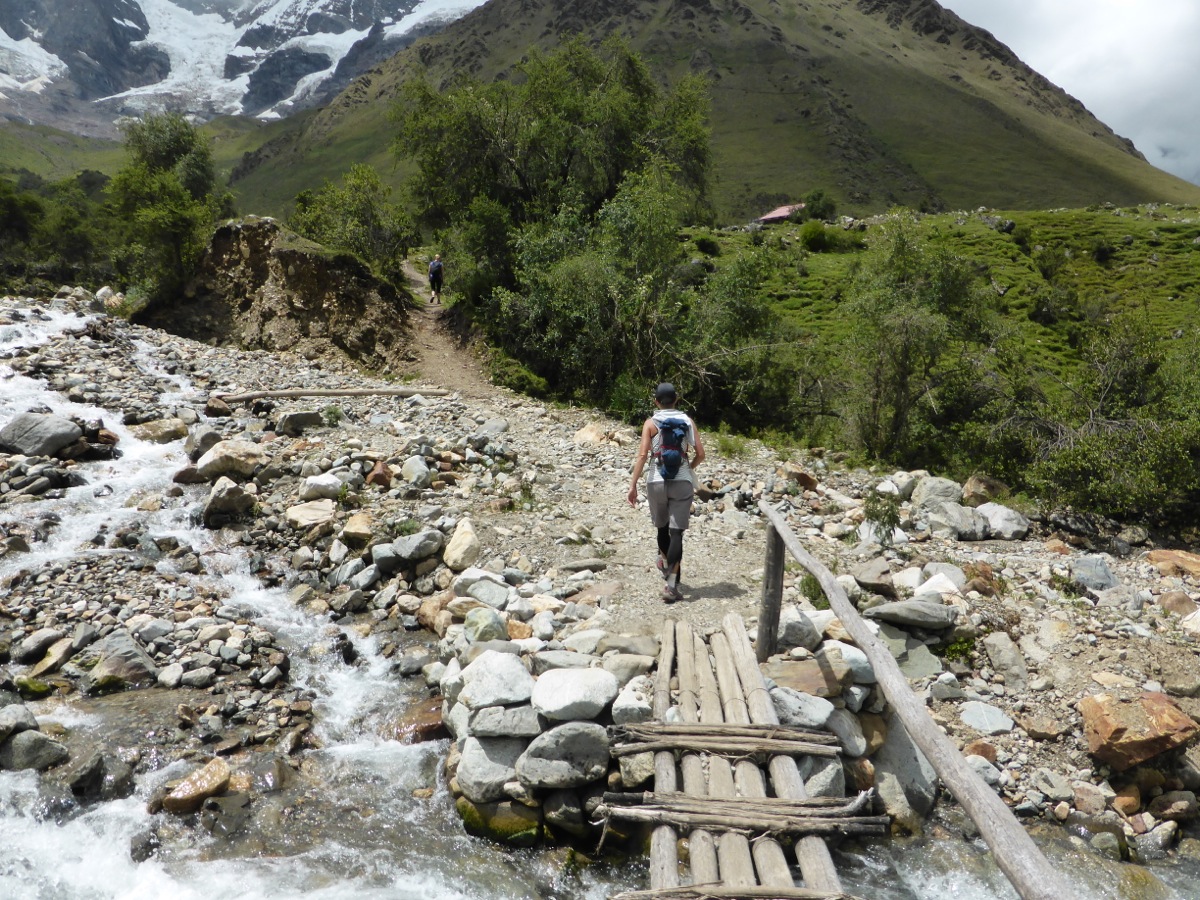
A river crossing shortly before our campground – this white water was voted “not runnable” by the Aussies, Jarred and Dan!
After roughly 4 hours we arrived to find our tents set up and our kitchen crew well into lunch preparation – amazing! Lunch was impressive – 3 courses and lots of coca tea! The campsite is a permanent installation run by a local community. They offer sheltered sleeping areas with concrete floors, flush toilets and eating enclosures for each group. There is also a little snack hut that sells water, soft drinks, beer and snacks (with a very generous mark-up!). Here we had a chance to interact with our new friends from Sweden and Switzerland – making use of a small whiteboard to write messages to each other.
Although we were really tempted to go for a nap after lunch, we couldn’t miss the short but steep 3km hike from the campsite up to Lake Umantay at 13,800 feet asl. For our 3 hours of hard work, our oxygen deprived band of trekkers were treated to a glorious sunny late afternoon and the most stunning views of the lake and glacial backdrop. An afternoon snack spread was waiting for us upon our return – freshly popped popcorn, cookies and hot chocolate! All vegan and absolutely delicious after an energetic day!
Dinner, with more great food, followed shortly after and our tour leaders briefed us on what to expect the following day, the longest and hardest of the trek. After admiring the bright starry sky, we headed for bed and what we hoped would be a restful and warm night.
Day 2 – 24km
After a cold, windy and noisy night with donkeys braying and cows mooing, we crawled out of our tent and packed up before breakfast. We were very unhappy to discover that a weather front had arrived overnight, cloaking the mountains in thick cloud. Our unhappiness shifted to near misery as the rain began to fall as we set out on our hike for the day!
This was the longest day of our trek, covering roughly 24km and reaching the summit of the Salkantay Pass at 15,250 feet asl within the first 6km. This was a tough 5 hours of single track and switchbacks, taking us into what looked like Middle Earth! The scenery was worth the effort though, and despite the rain and wind, we felt very accomplished when we arrived at the summit of the pass. Here we took a few minutes to rest and have a snack, imagining what majestic mountains were surrounding us, since everything was still cloaked in heavy cloud.
Creating an imposing presence along with many other peaks in the range, Salkantay Mountain reaches into the sky to an impressive 20,500 feet asl and is the second highest mountain in the Cusco region. We performed a ceremony to honour “Pachamama” (Mother Earth) and the mountain, according to local custom. This involved laying stones collected from Lake Umuntay alongside the stones placed by local people who make the daily trek up the mountain to honour Pachamama.
After a freezing half hour atop the pass, we began our descent. It was still raining when we arrived at our lunch stop an hour later. It was a welcome sight to see the meadow with shelter and the promise of hot drinks and food after our cold and wet morning. Again, it was amazing to see what our crew put together for lunch with very basic facilities, and of course, no electricity. We had soup, quinoa salad, steamed veggies, and pasta – our lunch was all vegan and very yummy!
The remaining part of the day’s rainy hike took us through meadows, hillside villages and muddy marshes, and alongside cliffs and streams. We arrived at our campsite around 5pm and quickly settled into our tent to warm up and change into dry clothes. Amazingly, our gear bags were dry and unscathed after the wet and muddy journey. The campsite was part of a cluster of permanent trekking shelters run by another local family. Facilities included flushing toilets, showers, kitchen and dining area, along with a raised wooden platform for tents. It was still very windy and had gotten quite cold by nightfall and we were very happy to huddle together with the rest of our group for another great dinner and conversation. Jarred and Dan introduced us to a few drinking games (obviously!) which spurred on laughter and general silliness after our long day.
Day 3 – 14km
We had a better night’s sleep and woke well rested to find the rain had stopped and the sun was making an appearance. Our 14km hike this day would take us along the edge of the Amazon basin, with dramatically different landscape and climate. Bev started the day with a spectacular slip and slide in the mud, landing in a marshy mess next to the horse stables on our way out of the campsite!

Preparing for the day’s journey and saying goodbye to our horsemen and pack animals as our gear was transported by car from this point
We walked on a dirt road alongside a river in the Santa Teresa Valley for most of the day’s distance. We stopped to enjoy passion fruit and bananas from a local plantation, and enjoyed seeing wild coffee and avocado trees. At one point we had to cross the river – luckily a local family had erected a cable way system with car to cross the water and we gleefully took advantage of it!
Our route allowed us to get a glimpse of rural life as we passed through villages and agricultural plantations. Here the foliage was much denser and overgrown than the mountains we had scaled over the previous two days. It was also warm and dry – a nice change from cold, windy and wet. We were very happy to be hiking in our running gear instead of layers of fleece and waterproof jackets!
We arrived at our lunch spot around 1pm where we enjoyed cold beer and another wonderful meal and much joviality! We spent a couple of hours relaxing and then piled into a minibus for transport to our campground in the village of Santa Teresa. After a quick change into our bathing suits, we piled back into the minibus and headed for the Santa Teresa hot springs.
It felt so good to jump into the warm springs and relax after our days of trekking. The pools are set against a rockface with natural rock “recliners” – perfect for lounging and soaking our weary bodies. It was also quite a treat to have a shower in the natural hot spring showers – after 3 days of no bathing we were ready for a rinse!
Back at the campground we warmed up with hot chocolate and treats and settled into our tents. Aside from the tents, this campground was also a permanent installation with ablutions (very sketchy at best), dining area and bonfire pit. This night is typically when the wrap up party for the trek takes place, and we could tell that it was going to be an interesting night when the reggaeton started pumping through the sound system! Many litres of Pilsen beer later and the party was firmly underway. Although our group was self-contained, we trekked alongside a group of Australians through Salkantay Trekking. Once the party started, it was mostly a mess of Aussies and Peruvians shaking it into the wee hours!
Day 4 – 10km
Our final day of the trek involved an early minibus ride to the starting point of our 10km walk at the Hydroelectric dam project. From here we followed train tracks and the Urubamba River into the town of Aguas Calientes. It was an easy walk with beautiful scenery which included rugged cliff sides and dense, green foliage. We were also excited to see glimpses of the outer fortifications of Machu Picchu perched high on the mountains along our route.
About a half hour before we arrived in Aguas Calientes, the rain started again. We quickly whipped out our trusty ponchos and fended off the wet. Even with the ponchos, we were absolutely and thoroughly drenched when we arrived at our hostel – our only night of indoor lodging instead of under stars and canvas. It was great to be able to take a hot shower and change into dry clothes, instead of trying to warm up in a campsite!
On the banks of the Urubamba River, Aguas Calientes is the hub for visitors to Machu Picchu. It hosts the terminus and departure point for bus and train transportation from Cusco. It’s one of the most touristy places we’ve visited and also one of the most disappointing. Some parts of the town are in a state of disrepair and the town seems to have developed too quickly. That being said, unfinished and mismatched buildings are a common part of the landscape in Peru, but it seemed far more pronounced in Aguas. This is especially disappointing since it sits at the foot of one of the most special and mystical places on earth.
We spent our last evening with our crew at a farewell dinner, obtained our Machu Piccu entrance tickets, and then made our way back to the hostel in the dark as the town had a power outage caused by the storm. We were again happy to be back in our warm and dry hostel, and ready for a good night’s sleep before our early morning departure for the ruins.
Day 5
Finally Machu Picchu day had arrived! All of our hard work over the past 4 days across roughly 60km was about to be rewarded with our final prize. We assembled at the bus station to catch the shuttle bus up the hill to the base of Machu Picchu. These shuttle buses run constantly throughout the day, ferrying visitors to and from the ruins. There is also a hike up to the ruins, which we opted to do on the way down.
The morning was very cloudy and misty, but fortunately no rain was falling. During our first hour on the ruins site, the structures remained hidden from us in the mist. As we toured the site with our guide, the skies started to clear and we were given our first breathtaking views of the city. We both found ourselves at a loss for words as we watched the magnificent scene unfold. Machu Picchu has to be seen to be fully appreciated. It has an intangible quality that permeates the air while enveloping you in a very visual and almost tactile experience.
The ruin site is very large, with distinct areas for the various requirements of the civilization that lived here. We spent 2 hours walking through the key ceremonial, residential and burial areas. The site also has tiered agricultural platforms that were used for planting various crops to sustain the population. Most of the core building structures have been preserved and/or restored, but the roofs of the homes are no longer in place.
An optional experience is a hike up Wayanu Picchu – one of the towering mountains overlooking the ruin site. There is an additional cost to access this part of the site, and only 400 visitors are allowed to ascend the mountain each day, in two timed waves of 200 people. We pre-booked our tickets with our tour operator, but early arrivals at the main ticket booth can also purchase a ticket on site until the quota is reached.
While steep and slippery at times, this hike was a highlight in a day that was already exceptional! The hike took us roughly 20 minutes up stone stairs featuring a few chain link handrails. Once at the top, the views over the valley and the ruins is spectacular. This vantage point gives one a different perspective and allows you to see the ruins in their entirety. There are also ruin structures on this peak, suggesting that this location was used by the spiritual leaders and the king for ceremonial and reflective purposes. We enjoyed our lunch while perched on a big boulder overlooking Machu Picchu – a most unique lunch spot indeed!
There are also short walks along the Inca trail leading away from the main city in various directions. One path leads to the Inca Bridge, a cleverly designed temporary bridge built into the cliff face that could be raised if a threat was presented. We also walked out to the Sun Gate, a control point for access to the city when it was inhabited. It also holds significance due to its alignment with the path and passage of the sun throughout the year.
There’s so much more to be said and shared about Machu Picchu. Even with all the tourists, it’s still possible to enjoy the sacred quality of the site and imagine how life must have been there. There are many marvels of engineering to be experienced and appreciated – from the agricultural innovations and security systems to the aqueducts and interlocking rocks that were hand hewn over generations.
We were sad to leave but the rain decided to return so we pulled on our ponchos and started our trek down the hill back to Aguas Calientes. An hour, and buckets of water later, we huddled into a cozy restaurant for a bite to eat before heading to the train station to board the train back towards Cusco with Perurail. Our very comfortable 2-hour journey terminated at Ollantaytambo, from where we caught a shuttle bus back to our hostel in Cusco late in the evening.
And so ended a truly rewarding, entertaining, challenging and awe-inspiring 5 days, culminating with the sights of Machu Picchu that won’t easily be forgotten or equalled. We were really pleased with the quality and organization of the trek and the friendly crew members. We also had a lot of fun with our group and its cast of funny and interesting characters! We hope to cross paths again somewhere along this marvellous adventure we’re on!
Bev thumbs up: Seeing Machu Picchu after an awesome trek and the new friends we made
Bev thumbs down: Not seeing the view from Salkantay Pass due to poor weather
Richard thumbs up: Clear view over Machu Picchu from Wayanu Picchu
Richard thumbs down: Aguas Calientes




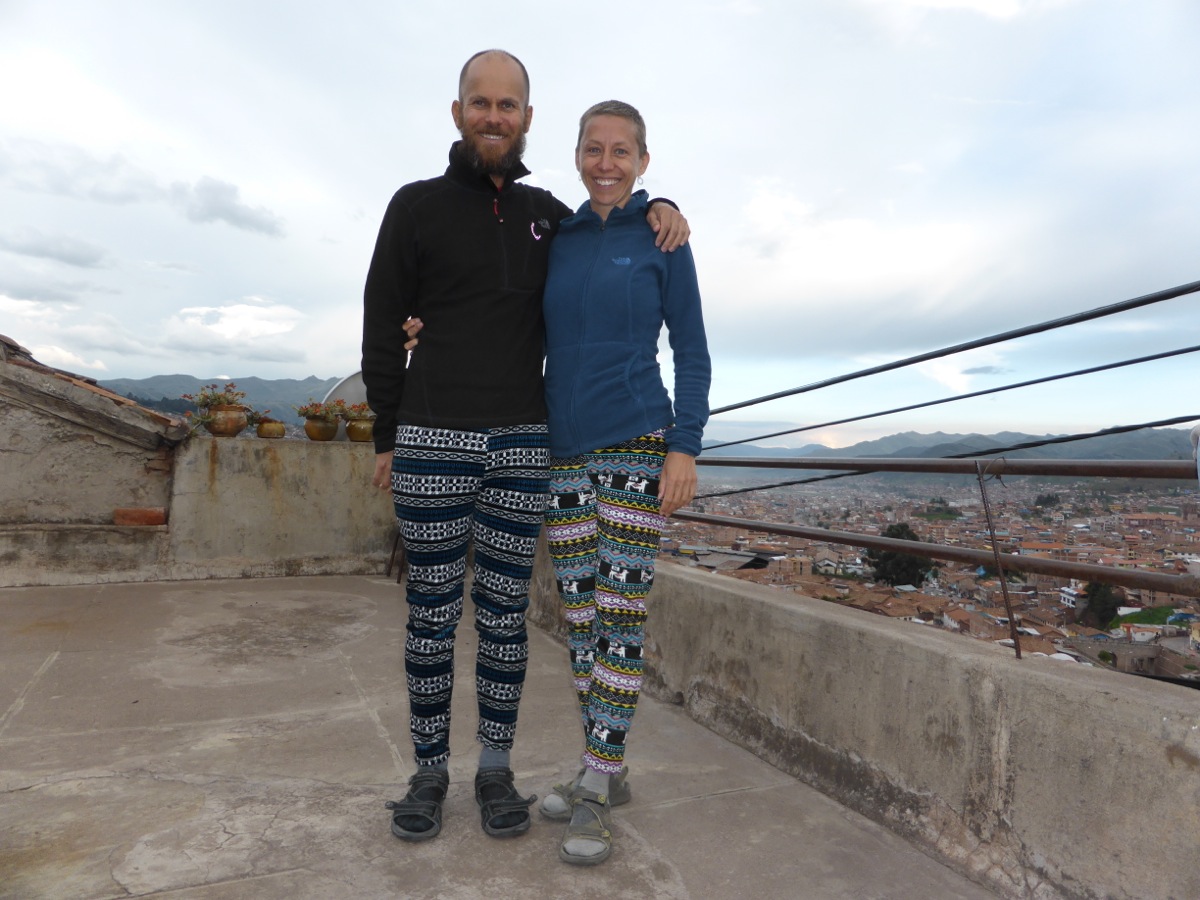

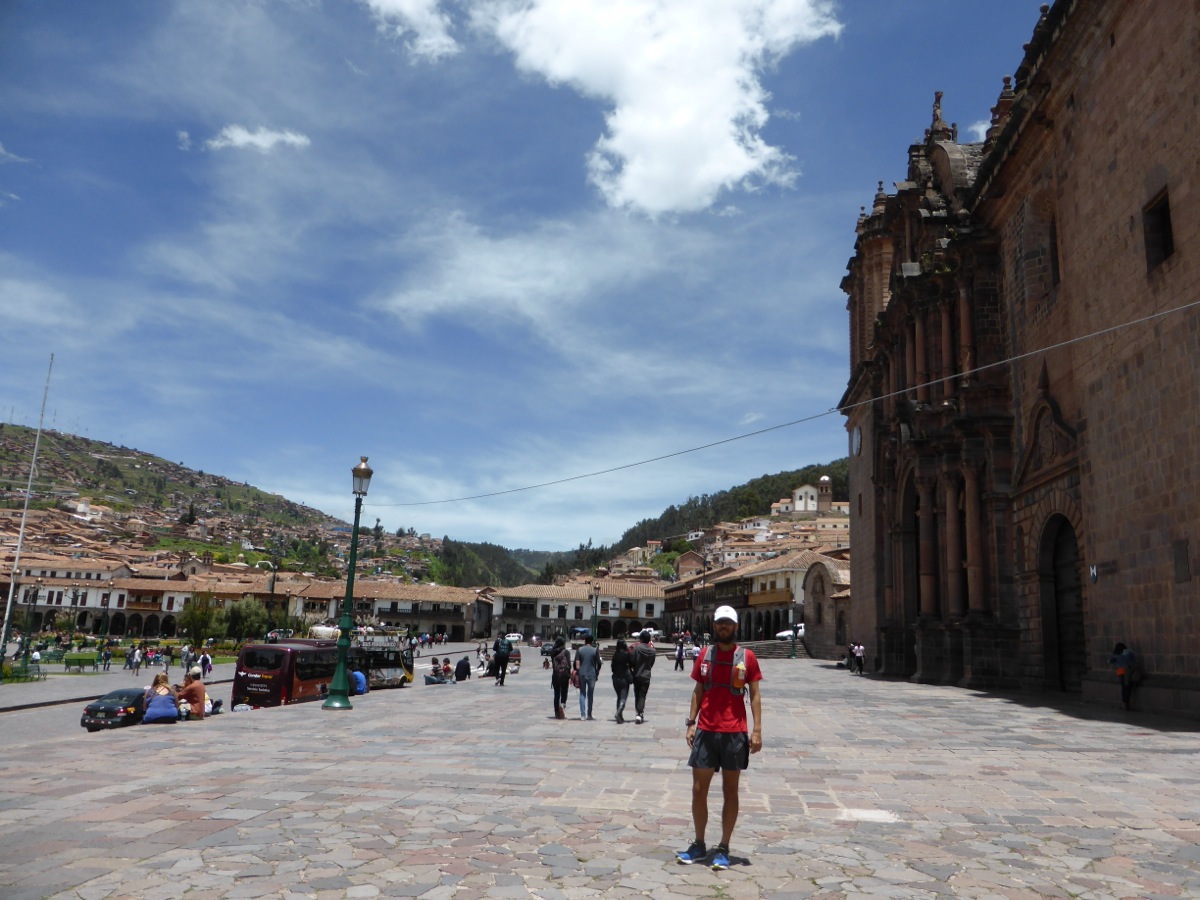



















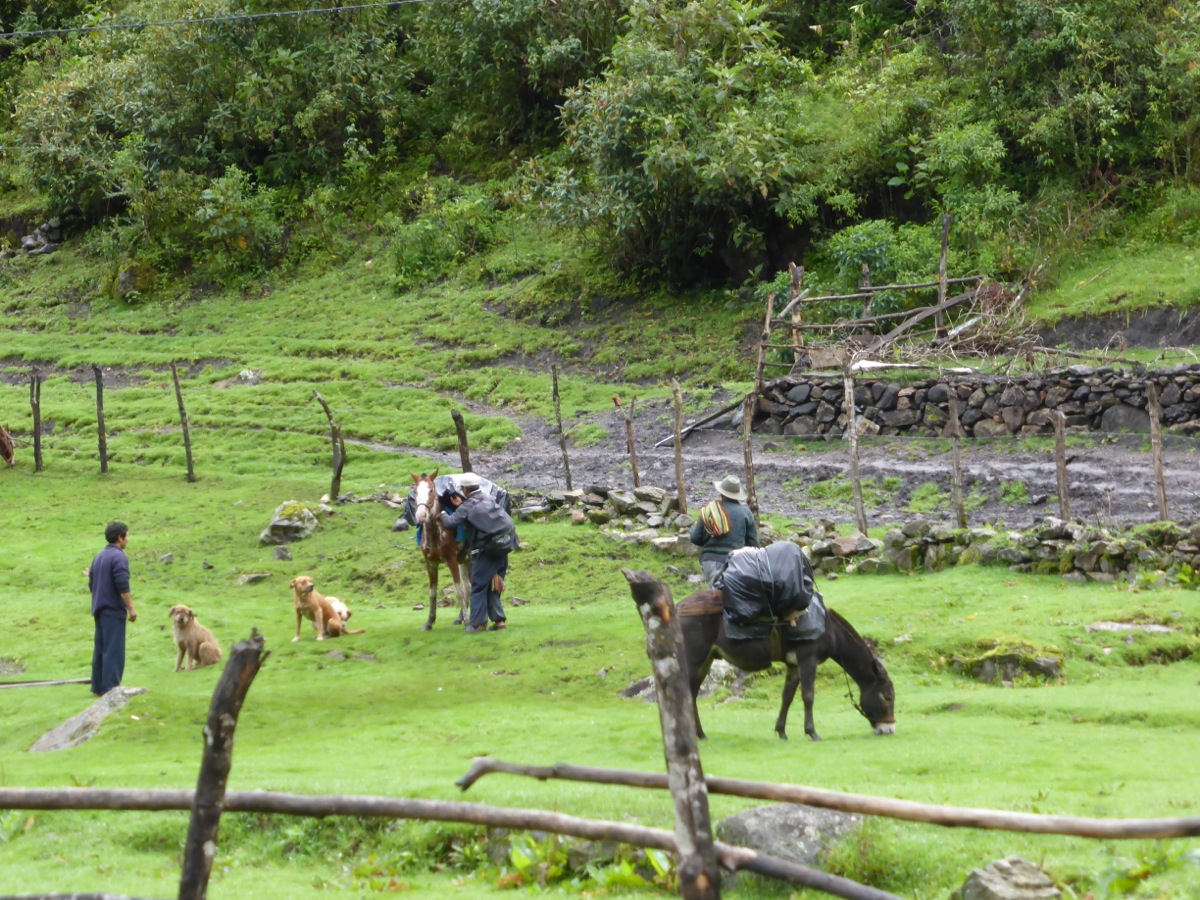
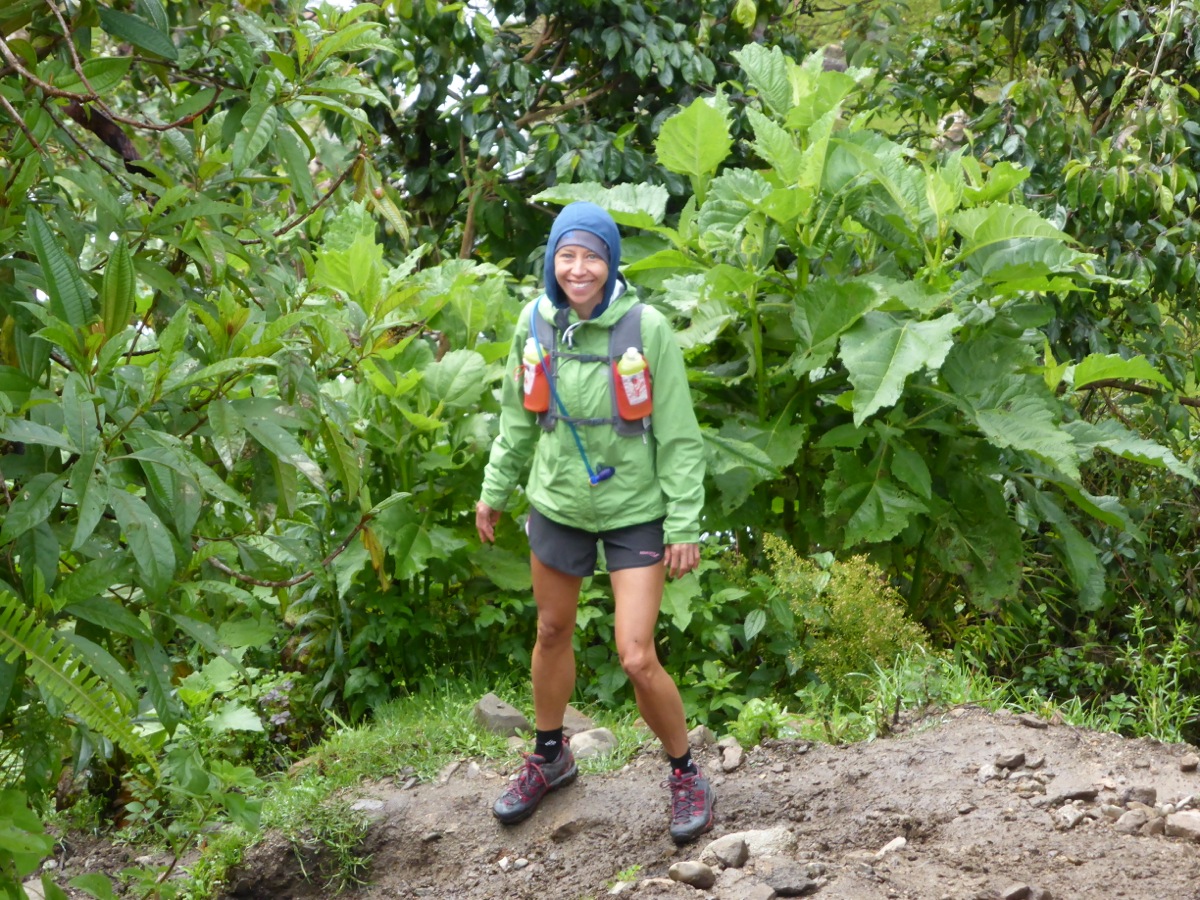








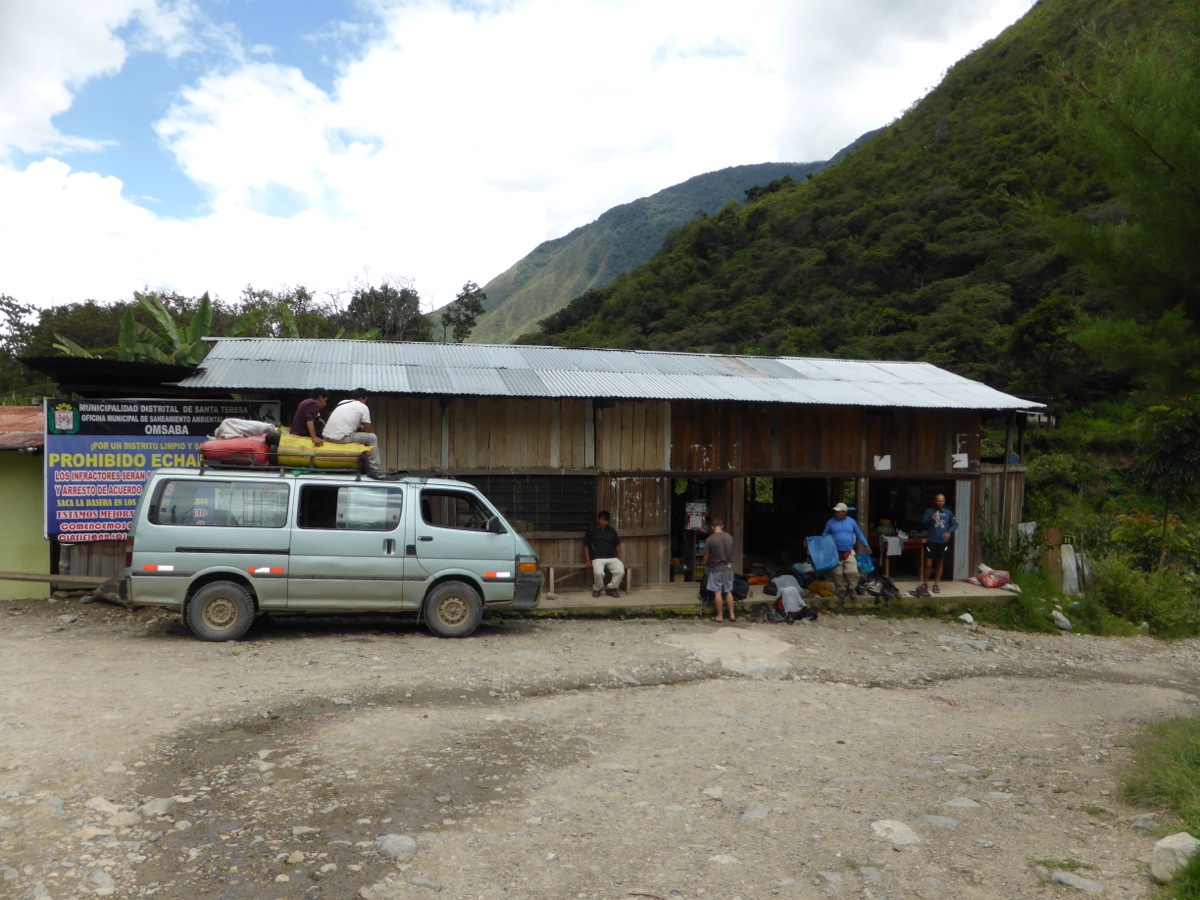




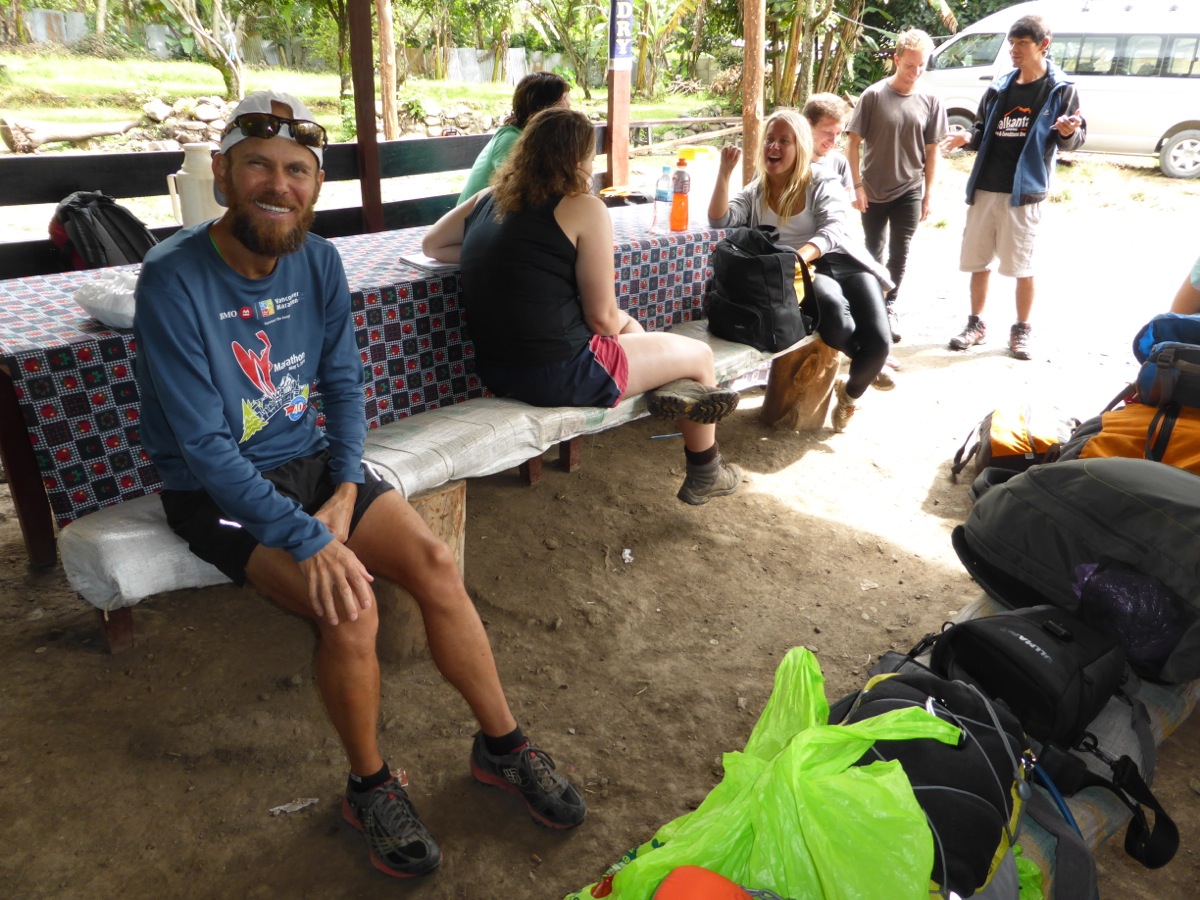







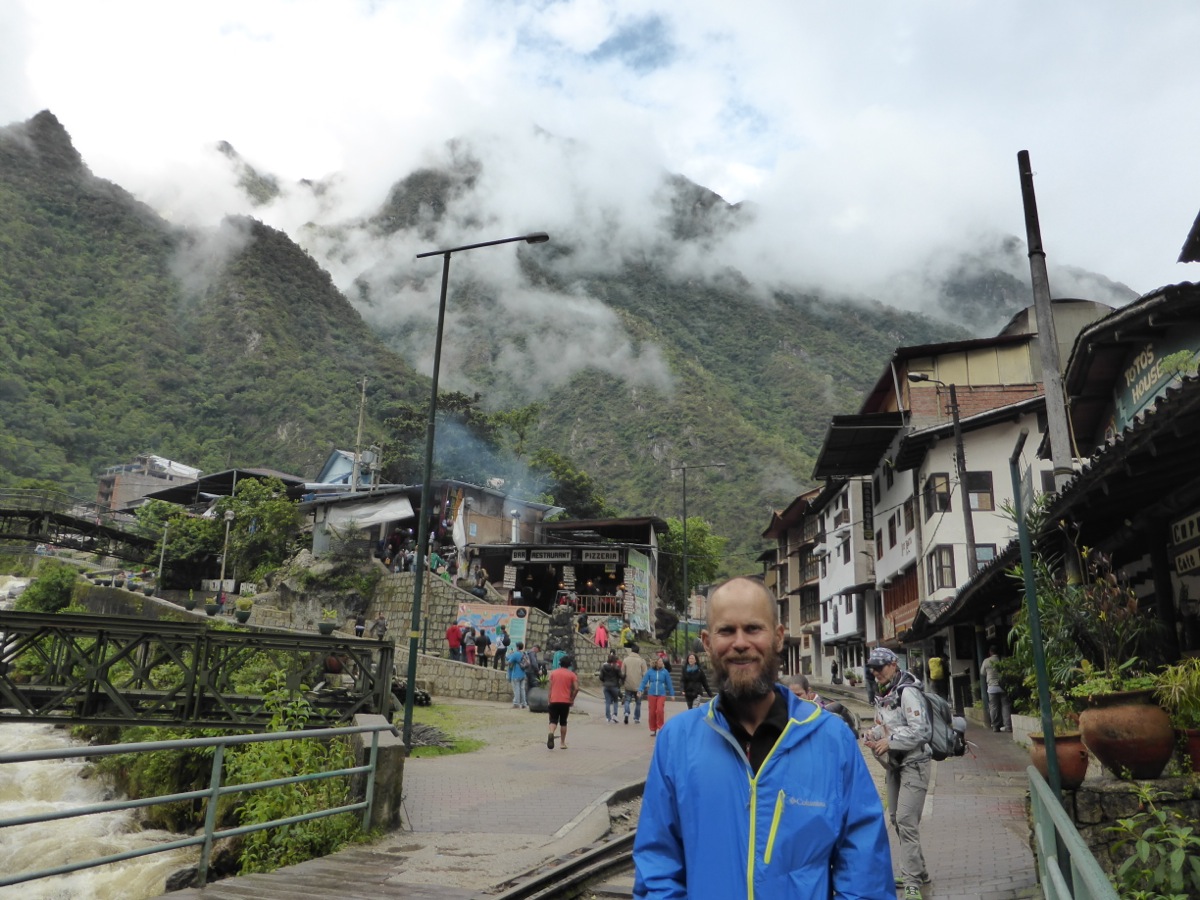

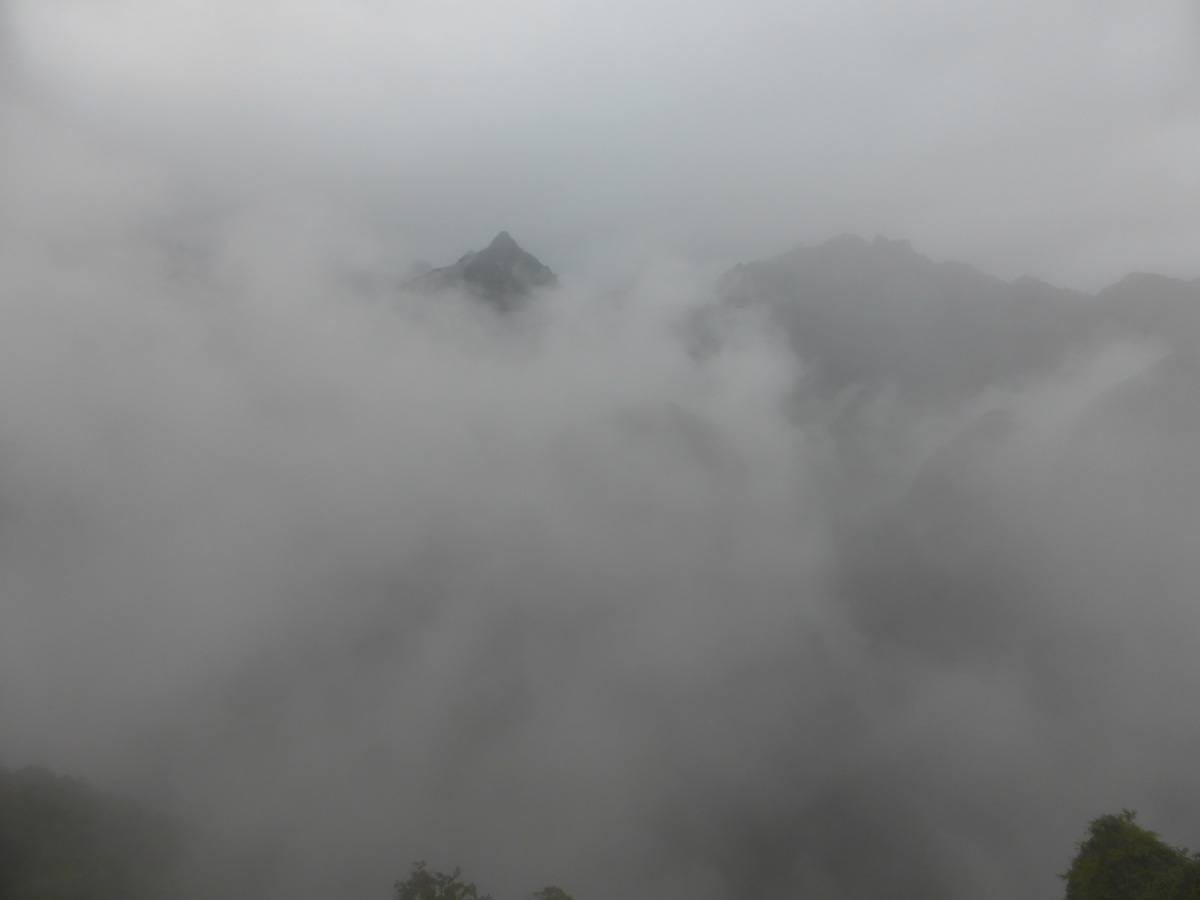











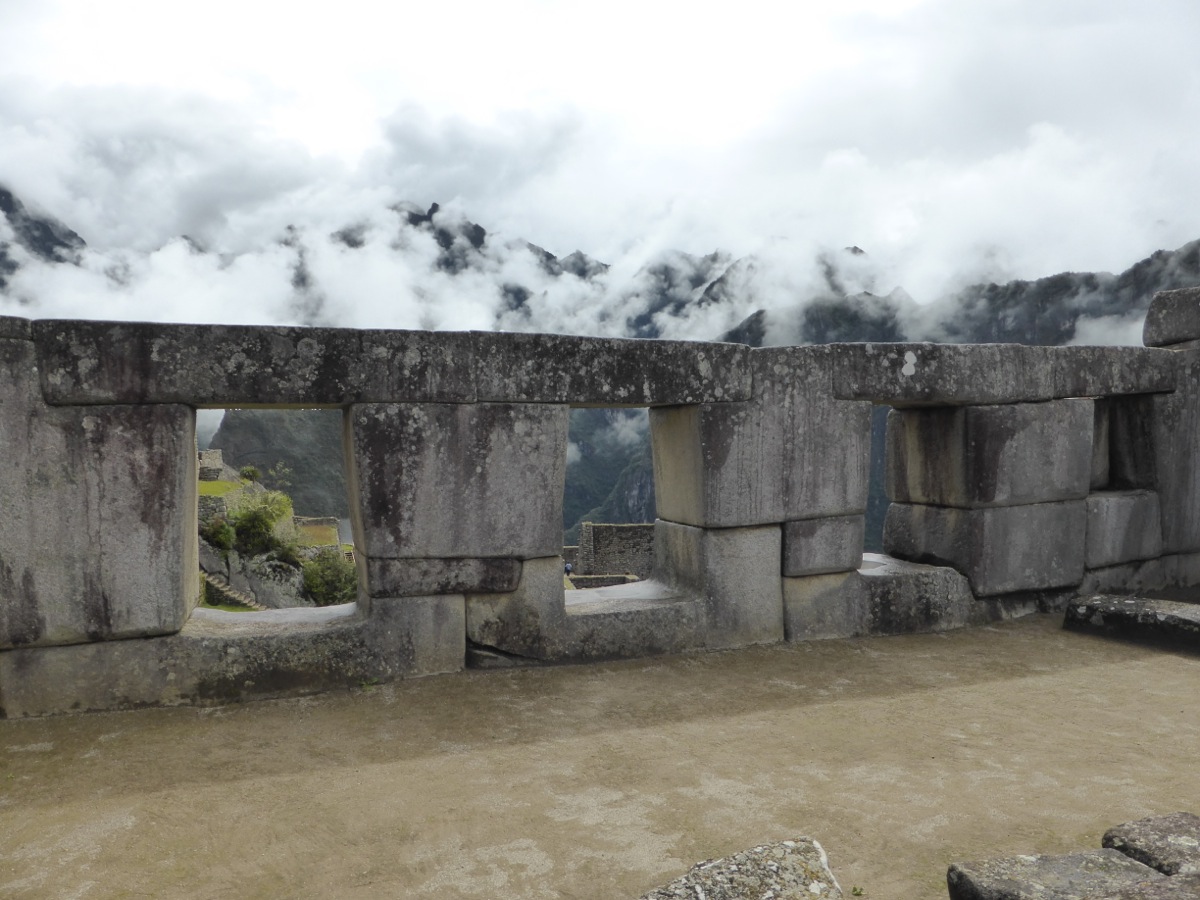









There are 2 comments. Add yours
Pingback: South Africa: Comrades 2014 | Our journey around the world... June 6, 2014
[…] Comrades, running and hiking many miles in the most fantastic training locations imaginable: Peru (read about our Salkantay trek to Machu Picchu here), Patagonia (report on our 6 day trek in Torres del Paine coming soon!!), Ipanema and Copa Cabana […]